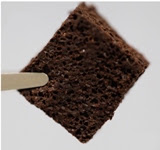New bioelastomeric foam filter cleans contaminated water
September 23, 2016

 Already considered by many to be possessed of almost magical properties, coffee has now been revealed to be more, much more than simply an essential and invigorating morning pick-me-up. Scientists have long known that coffee can remove heavy metals from water. Now researchers are putting that knowledge into practice, with the development of a foam filter that incorporates spent coffee grounds to remediate contaminated water. Simple and effective, it also offers a useful solution for the 6 million tons of spent coffee grounds collectively produced by homes, restaurants, and the coffee industry every year.
Already considered by many to be possessed of almost magical properties, coffee has now been revealed to be more, much more than simply an essential and invigorating morning pick-me-up. Scientists have long known that coffee can remove heavy metals from water. Now researchers are putting that knowledge into practice, with the development of a foam filter that incorporates spent coffee grounds to remediate contaminated water. Simple and effective, it also offers a useful solution for the 6 million tons of spent coffee grounds collectively produced by homes, restaurants, and the coffee industry every year.
This ability of spent coffee grounds, which are already used as fertilizer and converted into biodiesel, to remove heavy metals from water was first noted in 2000. Scientists found that coffee grounds contain either uncharged or negatively charged amine, carboxylic, and phenolic groups. The heavy metals dissolved in the water are positively charged, and therefore bind to the coffee. Hence, when contaminated water passes through the grounds, it leaves the metals behind. So far so good - but the difficulties arose when the researchers then tried to filter the coffee grounds out of the water.
Despina Fragouli and her colleagues at the Italian Institute of Technology came up with the idea of a  foam, which they produced by fixing coffee into a rubbery, porous material—a silicone foam that is cheap and easy to make. They mixed finely ground used coffee powder and a small amount of sugar into a solution of the elastomer acetoxy polysiloxane and a polydimethylsiloxane surfactant, after which the mixture was allowed to dry and polymerize overnight. A sugar leaching technique - the researchers dipped the material into warm water to dissolve the sugar crystals, leaving behind pores - was used to create a foam ‘sponge’ containing 60 to 70% coffee by weight. The sponge acted as a filter, removing up to 99 percent of lead and mercury ions from still water over 30 hours. In a more practical test in which lead-contaminated water flowed through the foam, it scrubbed the water of up to 67 percent of the lead ions. Also, real wastewater tests showed that the capability of the bioelastomeric foams to interact with lead and mercury ions is not affected by the presence of other metal ions in water as tests.
foam, which they produced by fixing coffee into a rubbery, porous material—a silicone foam that is cheap and easy to make. They mixed finely ground used coffee powder and a small amount of sugar into a solution of the elastomer acetoxy polysiloxane and a polydimethylsiloxane surfactant, after which the mixture was allowed to dry and polymerize overnight. A sugar leaching technique - the researchers dipped the material into warm water to dissolve the sugar crystals, leaving behind pores - was used to create a foam ‘sponge’ containing 60 to 70% coffee by weight. The sponge acted as a filter, removing up to 99 percent of lead and mercury ions from still water over 30 hours. In a more practical test in which lead-contaminated water flowed through the foam, it scrubbed the water of up to 67 percent of the lead ions. Also, real wastewater tests showed that the capability of the bioelastomeric foams to interact with lead and mercury ions is not affected by the presence of other metal ions in water as tests.
Because the coffee is immobilized, it is easy to handle and discard after use without any additional steps, the researchers say. “This makes it realistic to use spent coffee in a large scale application,” said Fragouli. The foams can be used for the continuous filtration and removal of metal ions from water, “demonstrating their versatility, in contrast to the sole coffee powder utilized so far, opening the way for the reutilization and valorization of this particular waste”, the scientists wrote in their recent article on the topic.
“We are exploring ways to remove metal ions from the foams without altering their functionality so they can be reused,” Fragouli says. The researchers are planning to develop fully biodegradable foams to make disposal simpler and more cost effective. The team has also begun making the foam from elastomers that spontaneously become porous during polymerization by forming gas bubbles, eliminating the need for sugar in the process.
The original article appeared in ACS Sustainable Chem. Eng. 2016, DOI: 10.1021/acssuschemeng.6b01098, under the title “Spent Coffee Bioelastomeric Composite Foams for the Removal of Pb2+ and Hg2+ from Water”.
About the Author(s)
You May Also Like


